Shropshire’s Baroque masterpiece, with ‘one of the finest interiors in England’, for sale for the first time in half a century
Mawley Hall is nothing less than one of Britain's finest privately-owned stately homes – a truly unique opportunity for whoever takes on this wonderful place.
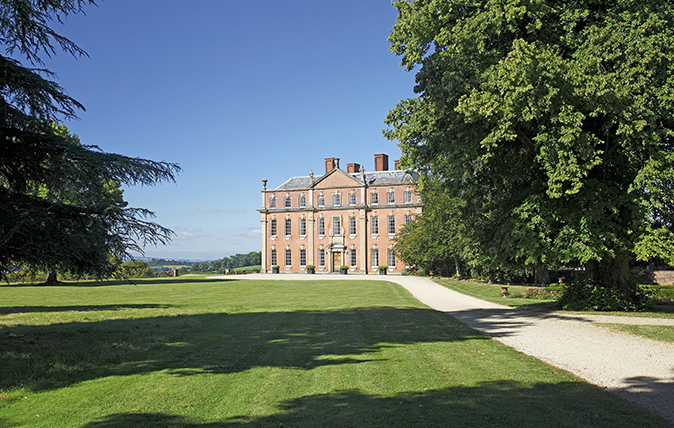

For sale for the first time since 1962 – at a guide price of £10 million through Savills and Strutt & Parker – is peerless Grade I-listed Mawley Hall, near Cleobury Mortimer, Shropshire.
This extraordinary building stands in some 550 acres of landscaped formal gardens, rolling parkland and farmland, ‘looking forth from its spur of the Clee Hills upon an almost limitless picture of hill and dale, field and wood, occupying one of the loveliest sections of our Western Midlands’.
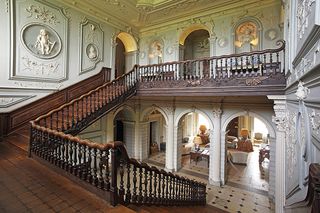
The setting evoked in Country Life back in July 1910 remains largely unchanged since the arrival of the Blount family in these parts in the early 14th century.
But that is only part of the charm. Almost miraculously, the imposing Palladian mansion designed by Francis Smith of Warwick for Sir Edward Blount (the 4th Baronet) in about 1730 has remained almost entirely unaltered since it was built. The sole major change is an extension to the dining room in the style of Robert Adam, added by Sir Walter Blount, the 6th Baronet, in the late 1700s.
The Blounts were a staunchly Catholic family, with numerous branches, one of which had its seat at Sodington Hall, Worcestershire, on the opposite bank of the Teme from Mawley Hall. In the 17th century, one of the more prominent family members was Sir Walter Blount, a successful lawyer, MP and Sheriff of Worcestershire.
His zeal for the Royalist cause during the Civil War earned him a baronetcy in the early years of the conflict, but incurred the wrath of the Puritans, who eventually captured him at Hereford and sent him to the Tower. In revenge for his refusal to make arms for the Model Army at the family forge, his Sodington estate was confiscated and his mansion burnt down, although both appear to have been restored to his son.
https://player.vimeo.com/video/233823586
Sign up for the Country Life Newsletter
Exquisite houses, the beauty of Nature, and how to get the most from your life, straight to your inbox.
By the early 18th century, Blount family fortunes were once again on the rise and, in the late 1720s, Sir Edward Blount, the 4th Baronet, decided to replace the existing hall with the present grand mansion, helped, no doubt, by the generous Throckmorton dowry brought by his wife, Apollonia.
However, as one insider observes, ‘the early 18th century remained a sensitive time for Catholics in England, and excessive outward gestures of wealth were constrained. Mawley, with its relatively modest red-brick (as opposed to stone) exterior, is an important example of this.
On the other hand, as a result of spending less on the exterior, the interior was executed seemingly without budget, which is why Mawley has one of the finest and most eclectic interiors in England’.
In the early 18th century, plasterwork was the most expensive and most exuberant form of interior decoration and Mawley’s stucco hall is among the finest examples of the art to be found anywhere in the world.
Budgetary considerations aside, one of the reasons for the exquisite craftsmanship to be found throughout Mawley Hall is the fact that Smith of Warwick was the master builder to the influential architect James Gibbs, whose work spanned the transition between the English Baroque and the Georgian architecture inspired by Palladio.
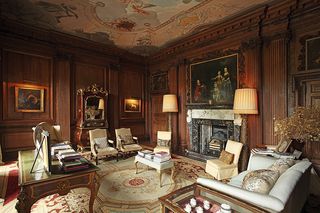
As such, Smith had access to, and relationships with, some of the best foreign artisans working in England at the time, including the master stuccodore Francesco Vassalli, and it is to him that the exquisite Italianate plasterwork of Mawley’s reception and staircase hall is attributed.
‘Nothing could more beautifully underline the Baroque interest in restless movement than the extraordinary undulating handrail of Mawley Hall’s main staircase,’ enthuses Country Life’s Architectural Editor John Goodall. Indeed, not only is it difficult to find a freestanding staircase on the same scale from the period, given the engineering complexity involved, but there is apparently no known precedent for the serpentine handrail, which is unique to the house.
For many experts who have visited and stayed at the house, the marquetry of the Inlaid Drawing Room is said to be ‘without parallel in the UK and highly unusual’. The Oak Drawing Room in the south-east corner of the Hall is lined with finely carved and ornate oak panelling in the style of Grinling Gibbons, with a trompe l’oeil fresco ceiling by Graham Rust based on Milton’s Paradise Regained, commissioned in 1978 during Rust’s time at Ragley Hall, Warwickshire.
Also notable is the formal dining room, conceived some 40 years after the house itself and attributed to Robert Adam, which has moulded cornicing, Corinthian columns and a large curved alcove with moulded friezes.
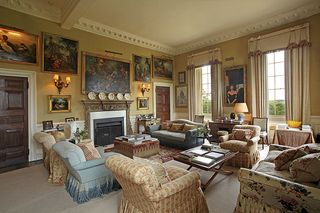
As is the norm with country houses designed by Smith, Mawley Hall’s 21,616sq ft of living space is simply laid out over four floors, with the principal rooms on the ground floor being of particular architectural importance. The first floor offers five bedroom suites, each having large sash windows for maximum light and magical views over the surrounding countryside.
The second floor, which needs updating, has seven further bedrooms, including two bedroom suites.
The lower-ground floor, historically the servants’ domain, has been remodelled by the present owners and includes a strongroom, a wine cellar, offices and stores.
However, it’s not just Mawley Hall’s interior that captivates: the estate’s mainly ring-fenced acres offer everything a classic English country estate should, including an impressive, Grade II-listed converted coach house, five houses and cottages, landscaped formal gardens with temples and follies, an exceptional high-bird pheasant shoot and two miles of fishing on the River Rea.
This country idyll is a far cry from the dilapidated Mawley Hall estate that went under the hammer in November 1960, when the Hall and 121 acres were bought for £15,500 by J. E. Talbot, MP for Brierley Hill, who sought to demolish the house. However, the Ministry of Works intervened, intimating that the property should be sold to a private buyer who would undertake the necessary, extensive repairs.
A year or so later, a saviour appeared in the shape of Anthony Galliers-Pratt, who bought the estate and immediately instructed Knight, Frank and Rutley to have the renovations put in hand.
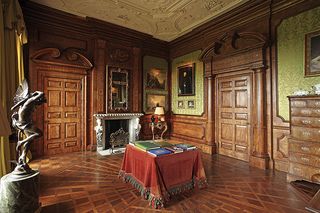
Working closely with the Ministry of Works and the Historic Buildings Council, he undertook a complete renovation of the house, a mammoth undertaking that included the replacement of all the exterior stone facings, the landscaping of the park and drives and the creation of Mawley Hall’s splendid gardens.
The gardens in particular were a labour of love on the part of Mrs Galliers-Pratt. Over the ensuing 22 years she completely transformed the scene by planting hundreds of trees and shrubs, creating avenues and vistas, developing an arboretum, rose and herb gardens and building a folly, all recorded in the pages of Country Life back on March 5, 1987.
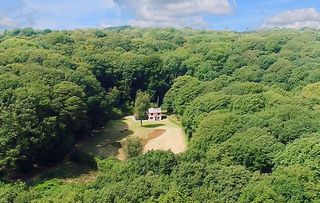
An unbelievably romantic home tucked away in a fairytale wood
Colwell Wood Cottage has the most unimaginably romantic location in the heart of 75 acres of ancient and unspoilt woodland.
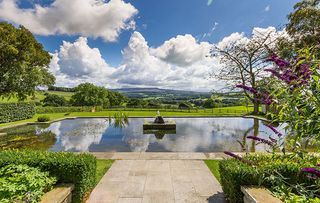
A mansion with glass floor and rooftop garden which a legendary singer once used as a fishing lodge
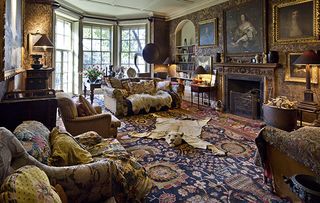
At home with Uncle Monty: Design cues from the Withnail and I icon
Thirty years after the release of Withnail and I, Arabella Youens examines the stylistic legacy of the fictional character's taste
-
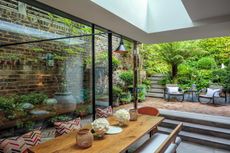 How to make a gloomy city garden into a haven of colour and nature
How to make a gloomy city garden into a haven of colour and natureTiffany Daneff discovers how to transform a typically dark London back garden into a light-filled green haven that is always in use. Photographs by Clive Nichols.
By Tiffany Daneff Published
-
 The world's hairiest animal, Saturday Night Fever and winning the lottery twice: Country Life Quiz of the Day 21 February 2025
The world's hairiest animal, Saturday Night Fever and winning the lottery twice: Country Life Quiz of the Day 21 February 2025Have a stab at our Quiz of the Day. Good luck!
By Toby Keel Published
-
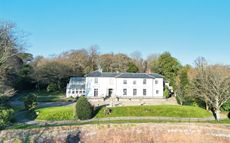 Classical style meets fun and flair in a seven-bedroom manor in Cornwall
Classical style meets fun and flair in a seven-bedroom manor in CornwallAt Polstrong Manor, the current owners have combined period charm and elegant modern interiors to create a flamboyant country home 10-minutes from the beach.
By James Fisher Published
-
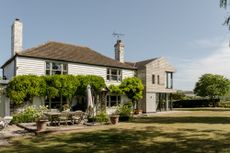 Two halves make a sublime four-bedroom home in Kent's North Downs
Two halves make a sublime four-bedroom home in Kent's North DownsA contemporary extension to a traditional clapboard house brings light and life to Lavington House.
By James Fisher Published
-
 The week in property statistics: Service charges reach record high
The week in property statistics: Service charges reach record highPlus, how first-time buyers prop up the mortgage market, why you need to move north if you want to live by yourself, and house-price growth slows
By Annabel Dixon Published
-
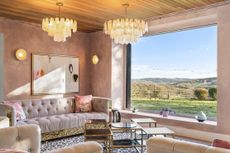 A seven-bedroom oast house for sale in East Sussex, where your dreams can run riot
A seven-bedroom oast house for sale in East Sussex, where your dreams can run riotUnlisted, yet full of character, this property in the High Weald National Landscape is an eccentrically furnished family home that screams fun.
By James Fisher Published
-
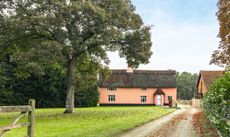 Character, history and comfort combine in a four-bedroom farmhouse in Norfolk
Character, history and comfort combine in a four-bedroom farmhouse in NorfolkWillow Farm near Southburgh is that rarest of things — a perfect combination of period charm and modern elegance in some of England's best countryside.
By James Fisher Published
-
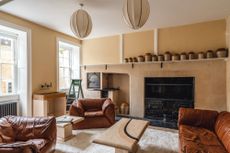 A Grade I-listed Georgian townhouse that's part of the fabric of Bath's history
A Grade I-listed Georgian townhouse that's part of the fabric of Bath's historyWith 5,500sq ft set over six floors in the centre of Britain's most architecturally rich city, there is much to love here.
By James Fisher Published
-
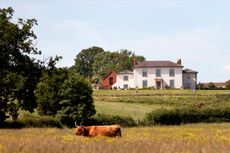 17 delightful homes for sale, as seen in Country Life
17 delightful homes for sale, as seen in Country LifeOur round-up of some of the best houses to come to the market via Country Life this week includes a wonderful Cotswolds home and a happily affordable cottage in the West Country.
By Toby Keel Published
-
 'This is the most money you'll spend on anything ever': The things that really matter when buying your first home in London
'This is the most money you'll spend on anything ever': The things that really matter when buying your first home in LondonIt’s easy to dream of what the ideal first-home in London might be, but when the cost of living in the capital is this expensive, being near a Gail's isn't as important as you think it is.
By James Fisher Published
